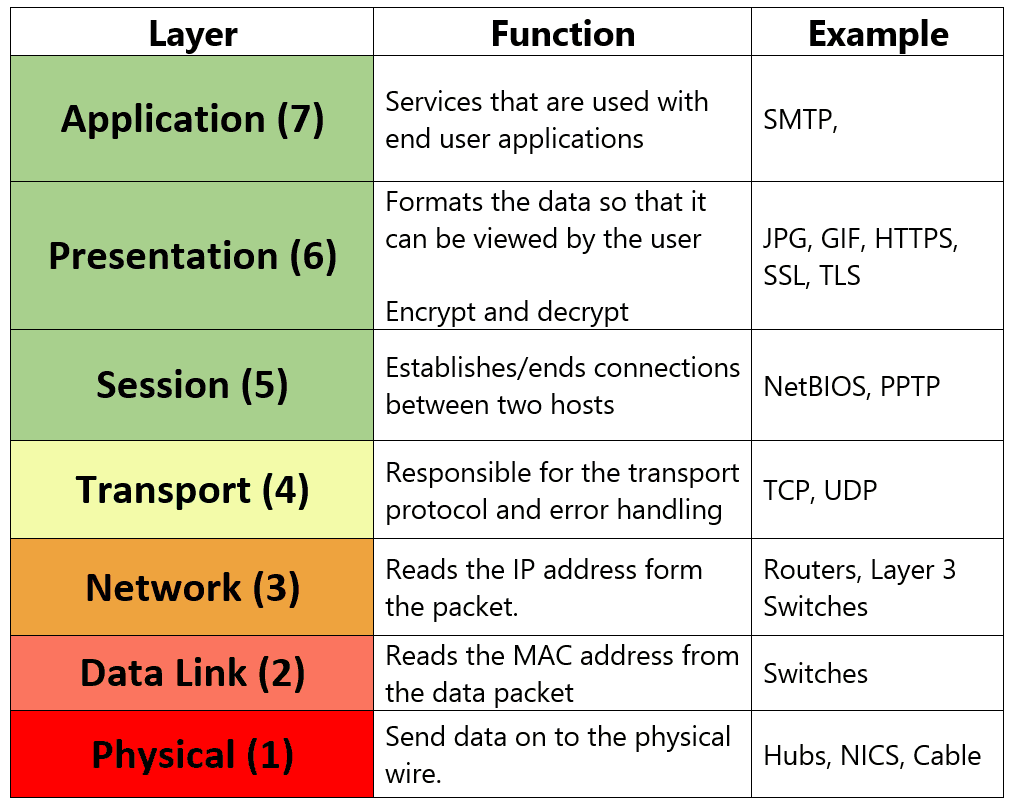I had an interesting day at work trying to figure out how best I can setup a service for a client who is sending UDP licensing traffic through some high-end networking devices over VPN. UDP by design is unreliable. This was causing issues as the UDP packet size was over the recommended size. The field size sets a theoretical limit of 65,535 bytes (8 byte header + 65,527 bytes of data) for a UDP data-gram. The practical limit for the data length which is imposed by the underlying IPv4 protocol is 65,507 bytes (65,535 − 8 byte UDP header − 20 byte IP header. Their packet was fragmenting and I had to go back to networking basics and start from Layer 2. Found the problem in Layer 4 (yes, it’s UDP fragmentation issue). I found the following OSI model explanation useful.
The OSI model breaks the network communications process into seven separate layers. I found few articles interesting and decided to splice them to create a post.
Layers 5 through 7 are generally referred to as the upper layers. Conversely, Layers 1 through 4 are collectively called the lower layers. Here are some mnemonic phrases to help you remember the layers of the OSI model:
- “Please Do Not Throw Salami Pizza Away”
- “All People Seem To Need Data Processing”
- “Please Do Not Tell Secret Passwords Anytime”
From the top, or the layer closest to the user, down, these layers are:
- Layer 1 – Physical: The Physical layer’s name says it all. This layer defines the electrical and physical specifications for the networking media that carry the data bits across a network.
- Layer 2 – Data Link: As its name suggests, this layer is concerned with the linkages and mechanisms used to move data about the network, including the topology, such as Ethernet or Token Ring, and deals with the ways in which data is reliably transmitted.
- Layer 3 – Network: This is the layer on which routing takes place, and, as a result, is perhaps the most important OSI layer. The Network layer defines the processes used to route data across the network and the structure and use of logical addressing.
- Layer 4 – Transport: The functions defined in this layer provide for the reliable transmission of data segments, as well as the dis-assembly and assembly of the data before and after transmission.
- Layer 5 – Session: The Session layer establishes, maintains, and manages the communication session between computers.
- Layer 6 – Presentation: This layer is concerned with data representation and code formatting.
- Layer 7 – Application: The Application layer provides services to the software through which the user requests network services. Your computer application software is not on the Application layer. This layer isn’t about applications and doesn’t contain any applications. In other words, programs such as Microsoft Word or Corel are not at this layer, but browsers, FTP clients, and mail clients are.
PDU Names on the Layers of the OSI Model
Each layer of the OSI model formats the data it receives to suit the functions to be performed on that layer. In general, the package of data that moves through the layers is called a Protocol Data Unit (PDU). However, as the data is reformatted and repackaged, it takes on unique names on certain layers. Table 1 lists the name each layer uses to refer to a message.
Absolutely memorize the information in Table 1 to the point that you can recite the data unit name associated with each of the OSI model’s layers.
| OSI Layer | PDU Name |
| Application | Data |
| Presentation | Data |
| Session | Data |
| Transport | Segment |
| Network | Packet |
| Data Link | Frame |
| Physical | Bits |
 blackMORE Ops Learn one trick a day ….
blackMORE Ops Learn one trick a day ….

This was a must have for CCNA, but only had a focus on upper layers. I really want to learn more about the actual packet process and development.
Nice Acronym
Hello,
Awesome post!
Hope it’ll bring great value for IT managers to using OSI layers in his projects. It’s really awesome to learn more about OSI model.
The OSI model breaks the network communications process into seven separate layers.
Do you face rush for a flight or office time, trouble to reach for a meeting on time; just book local taxi online with SearchGo cab app and go for a safe & secure Bike Taxi Services which never ride before.
nice content. thanks